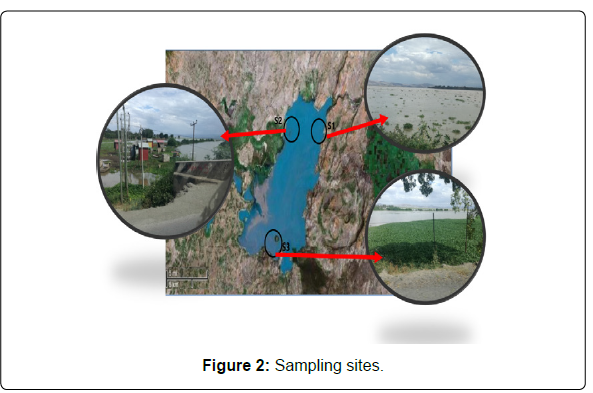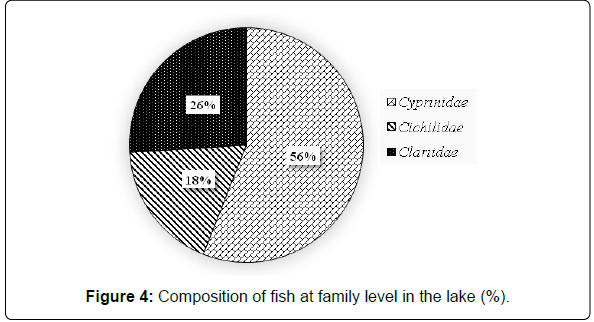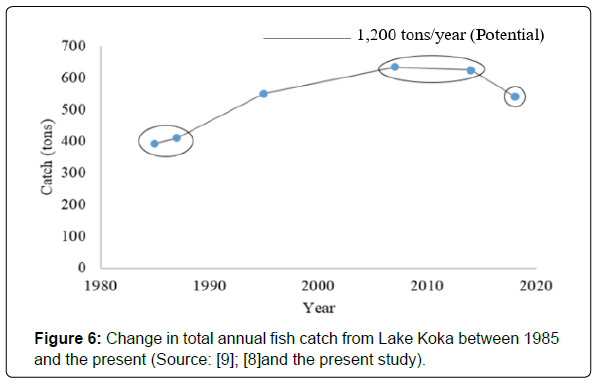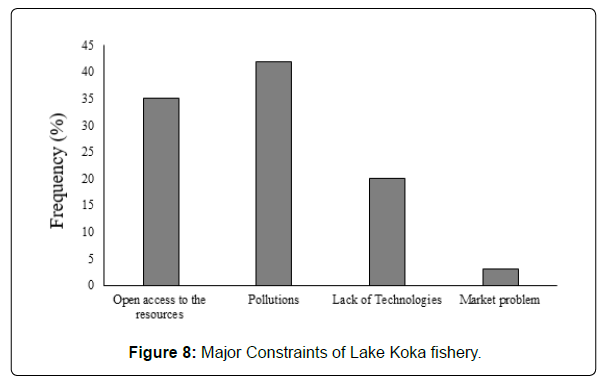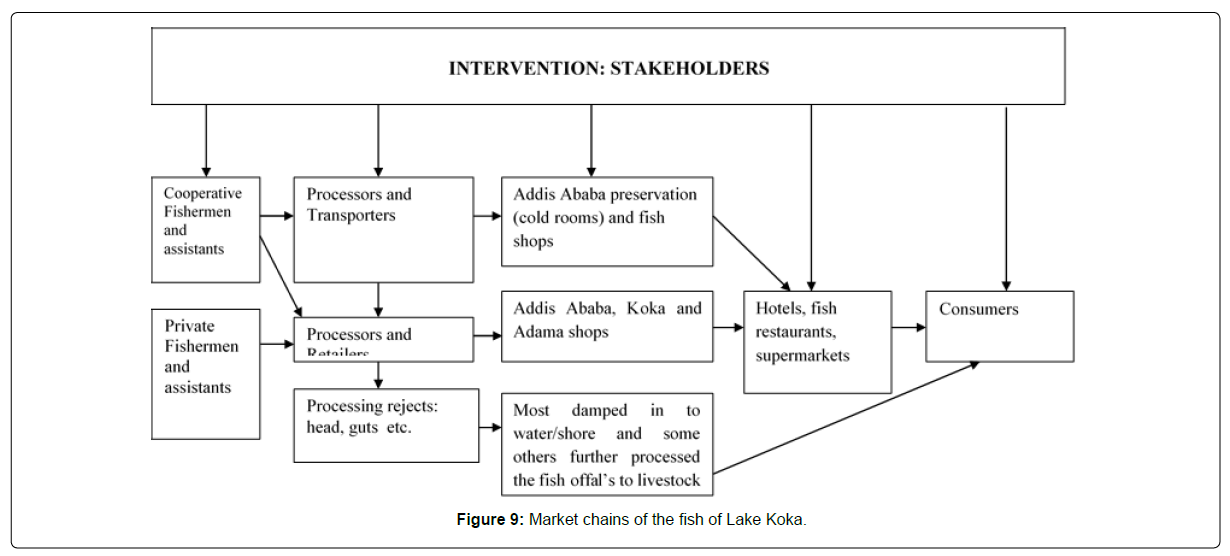Assessment of the Current Fishery Activities and Some Factors that Affect the Production of Fish in Lake Koka
Received: 19-Mar-2021 / Accepted Date: 20-Apr-2021 / Published Date: 27-Apr-2021
Abstract
Lake Koka is an economically important lake in the country. However, the physico-chemical parameters of the lake seem to be threatened by anthropogenic and climatic factors, which in turn affect biotic factors as reflected in fish catch. A study was made to assess the status of fishes and factors that affect the production of the fish in the lake during 2018. Four fish species were identified. The composition of the fishes has undergone changes as compared to the last few decades. For instance, C. gariepinus, attained the highest relative frequency (35%) in this study, next to Cyprinus carpio (36%), and then followed by O. niloticus (18%) and L. intermedius (11%). The fish catch of Lake Koka currently declined from 634 tons in 2007 to 542 tons in 2018. Most of the threats resulted from the anthropogenic impacts on the lake. Increased pressure in fishing was a problem in the lake. Currently, plenty of pumps are abstracting fresh water from the lake by state and private commercial farms throughout the year that are critically affecting the water level of the lake. As a result, the lake ecosystem is being affected by catchment degradation and siltation. The study suggested that if nutrient levels continue to increase and water levels continue to decline, further changes in fish composition can be expected in the lake, especially with a shift towards fish that are mainly turbidity-tolerant species such as C. carpio. The study showed that the fishery sector has been of critical importance to the economy and to the social well-being of the fishermen in the study area. However, current harvest trends and fishery conditions put these attributes of the production at risk. It is threatened with problems of pollutions, open access to the resources, lack of technology and marketing. Hence, appropriate management is an urgent requirement that could assist in sustainable exploitation of the resources, so that the resource could contribute to food security in the study area in particular and in the country in general.
Keywords
Fish composition; fish yield; fishery constraints; Lake Koka
Introduction
Lake Koka was constructed in early 1960s across Awash River mainly for hydroelectric power generation, and flood control [1]. It is located in an area with many agricultural activities and there are no soil conservation efforts in its catchment area. IBC [2] also reported that the situation of the lake ecosystem is being affected by catchment degradation, siltation, imbalance between water inflow and outflow and uncontrolled fishing practices.
Eventually, it started to support common carp, barbs, tilapia and catfish, most of which came from the river and the carp was very likely to have been introduced by early workers like Shibru Tedla, Feseha Haile Meskel and some FAO experts of the time. Koka has additional function of assimilating waste waters and industrial effluents from leather factories, flower farms, etc., which has made the water highly eutrophic leading to the development of toxic Cyanobacteria [3]. Such poisons coupled with pollution with heavy metals from the factories have started to cause serious health problems to local communities who directly drink the Koka water and bath in it [4]. There are allegations of skin diseases, retarded developments of children and even deaths according to documentary films by renowned media such as Al Jazeera.
The commercial fish production in the lake was intensified through the support acquired from Lake Fisheries Development Project and onwards, the fish stocks of the lake have declined for a variety of reasons. Lack of appropriate management of the fishery of the lake result that average size of the fish caught have continued to show a declining trend and this implies that the fish stocks are being depleted and the long-term effect of all these on water quality and on food webs is complex and affects the fish production of the lake. Hence, based on the historical data available on environmental as well as water quality, it is possible to assign fishery changes in the lake to identifiable factors. Hence, the objectives of this paper is therefore, to assess the composition and production trends of the fishes in the lake, to assess the variation in physico-chemical factors that influences the fish community structure of the lake and finally to identify the constraints that affects the production of the fish in the lake.
Methodologies
Description of the study area and site selection
Lake Koka is located in the Ethiopian Rift Valley (082302200N; 390501500E) at an altitude of 1,590 masl, which is about 120 km south of Addis Ababa. The lake had an initial volume of 1650 Mm3 [5], and surface area of 200 km2 [6]. The morphometric characteristics of the lake have, however, been changing due to progressive siltation. According to a review by [5], the reservoir had lost 28.9% of its water holding capacity by the year 1998 primarily due to siltation. The climate of the reservoir area characterized by bimodal rainfall pattern, with a maximum peak in August and a smaller peak in April (Figure 1).
Before starting regular sampling program, a reconnaissance survey was conducted to fix the sites. Hence, three sampling sites were selected based on geographical proximity and/or habitat similarity (neighboring floodplains, depth and distance to shore), their distance from human settlements and anthropogenic effect. Global Positioning System (GPS) was taken to demarcate the locations of the sampling sites, which presented during the survey.
Site 1 is located around the hydroelectric power station and relatively the deepest area of the lake, with a distance of 1.5 km from the tip of the mouth of turbine of the hydroelectric power. The area is mostly composed of mud. Site 2 is located in the western part of the lake and the shoreline is characterized by intensive cultivation with horticulture and field crops. Site 3 is located around the leather industry and as is the case with site 1, the area characterized as moderately cultivated (Figure 2).
Field sampling and measurements
Physico-chemical parameters:
Physico-chemical parameters of the water were measured monthly from each site during the study periods. Temperature, pH and conductivity of the lake was measured in situ at each sampling site. Temperature and pH were measured using a portable digital pH meter (Hanna 9024) and conductivity was measured using conductivity meter (Elmetron-model of CC411). Transparency was measured with a Secchi disc of 20 cm diameter
Water samples were collected from each site in dark plastic bottles, washed with acid and rinsed with distilled water several times in duplicates for nutrient analysis. Water samples for Chlorophyll-a determination was taken by the Schindler sampler from all sites. Finally, the samples was transported on ice to the laboratory for further analysis.
Fish parameters
Parallel to the physico-chemical sampling, every month the fishes were collected at each site using different of fishing gears, which includes gill nets of various mesh sizes (6, 8, 10 and 12 cm stretched mesh size) and longlines of different hook sizes (9, 10, 11 and 12). In addition, monofilament nets with various stretched mesh sizes (5 mm to 55 mm stretched mesh size) and multiple long-lines with hooks of different size (9, 10, 11 and 12) were used. The gears were set in the afternoon (4:00 pm) and collected in the following morning (7:00 am).
Catch and effort
Catch and effort data were recorded from the landing sites of the lake during the study period. Total landing by species in kg, the number and type of gears used for fishing and the number of settings for each gear was recorded. The number of gears in a community was monitored. Total effort per gear type was estimated based on the number of gears (gill net and hooks), settings (beach seine) and time (the number of days the gear was deployed in the month). The number of gears and settings in relation to fish catch in each gear was obtained through interviews with the fishermen. These data was also use as raising factor in the estimation of annual yield. A review was also made on the longterm trend of fish production from various published research results and unpublished data collected by different organizations.
Factors that affect the fish production
Some physico-chemical variables and fishing gears that directly related to the fishery were reviewed to assess its effects on the production of fish.
Constraints of the fishery in the lake
Selection of landing site and fishery cooperatives
Landing sites were selected on the shores of the lake that fishermen were used to catches the fish. Totally three major landing sites were purposively selected for the survey.
Sample size determination
Arsham’s (2005) mathematical formula, as indicated below, was used for sample size determination.
N = 0.25/SE2;
Where N = Sample size
SE = Standard error; which was calculated by using confidence interval of
10% and confidence level of 95%,
SE = 0.1/1.95 = 0.05, where 1.95 is constant
Totally 100 households were randomly selected and data were collected in the study area through semi-structured questionnaire interview and the content of the questionnaire includes main constraints of the fishery and the marketing system in the lake
Focus group discussion and key informants
Focus group discussions were held in the study area after filling out the questionnaires by way of interview. Members of the focus group were purposively selected to make a total of four to six members. The members included committee members of fishery cooperative, peasant association executive committee members, development agents, and the districts livestock and fishery development desk officers and individuals who were believed to be knowledgeable about the past and present status of the fishery of Lake Koka.
The leading check list of issues to be discussed at the group discussions were prepared to guide the discussion with the focus group with special emphasis on policy issues, external support for the schemes, institutional and managerial issues, major problems and future plans to further the development of the fishery of the lake.
In addition, secondary data were collected from published and unpublished sources. Bora, Lume and Adama Districts Agricultural and Natural Resource Development Offices, Cooperative Promotion Offices and Livestock Development Agency Desks were the important sources of data.
Results and Discussions
Fish species distribution and composition
A total of four species of fish in the Families Cyprinidae, Clariidae and Cichilidae were identified from the different sites in the lake (Table 1 and Figure 3). The species were Labeobarbus intermedius and Cyprinus carpio from the Family Cyprinidae,Clarias gariepinus from the Family Clariidae and Oreochromis niloticus from the Family Cichilidae. The status (presence/absence) of the species from the sampling sites was provided in (Table 1).
| Family | Fish species | Sampling Sites | ||
|---|---|---|---|---|
| S1 | S2 | S3 | ||
| Cyprinidae | Labeobarbus intermedius | + | + | + |
| Cyprinus carpio | + | + | + | |
| Clariidae | Clarias gariepinus | + | + | + |
| Cichilidae | Oreochromis niloticus | + | + | + |
Table 1: Fish species identified from the study sites of Lake Koka (Present (+), Absent (-)).
A total of 2019 fish specimens were recorded from the three families during the study period. The species wereC. carpioand L. intermedius from the family Cyprinidae (56%); Oreochromis niloticus from the family Cichilidae (18%); and Clarias gariepinus from the family Clariidae that accounts 26% (Figure 4).
At species level, C. carpio was the dominant fish species from the Family Cyprinide as well as the whole species from the lake and it accounts to 36 % of the total catch. Clarias gariepinus was the second dominant species that accounts to 35%. O. niloticus and L. intermedius were represented in the catch with 18 % and 11 %, respectively (Figure 5).
Annual fish catch
Lake Koka fisheries have been developing over the past decades and the lake was part of the eight major lakes considered by the lake fisheries development project (LFDP) in 1990s[7]. Koka is among the most important lake for Ethiopian small-scale fisheries in general and riparian societies in particular[8]. At present, it provides about 542 tons of fish annually (Fig.6). Currently O. niloticus, C. gariepinus and C. carpio were commercially important fish species in the lake. Of these C. carpio and C. gariepinus comprise more than 70 % of the annual catch.
The annual fish catch of the lake shows different trends with time (Figure 6). The first fishing phase was around 1985, which was a period of fisheries where the catch has been lower with a mean annual catch of 393 tons. The possible reason for the stability was low number of active fishing gears in the lake. The second phase was the growth period around 2007, which was a period when yield increased to 634 tons which has almost the recommended level. At this time additional and effective fishing gears were handed by fishermen. The third phase was the period in which fish catch declined to 542 tons during the study period.
Factors that affect the fish production of the lake
Fishing gears
Three types of gears were operated in the lake: beach seines, gillnets and long-lines (Table 2); while hook-and-lines were utilized by occasional fishermen along the shoreline. The fishermen utilize wooden boats for casting beach seines and rafts for gillnets and long-lines. Beach seine was the most common fishing gear used, whose presence increased from about 60 in 2002 to 68 in 2018 while, the number of gill nets has decreased from 23 in 2002 to 23 (2018) (Table 2). The increase in destructive type of fishing gear (beach seine) in Lake Koka may be to increase the catch of the fish in the lake.
Water quality
Aside from problems related to decreasing water level of the lake, water abstraction started to induce salinity, due to loses of freshwater from the lake. Simultaneously, the application of agrochemicals and fertilizers due to intensification of irrigation practices around the lake has increased and affected the water chemistry of the lake (Table 3).
With the clearing of the vegetation in the watershed for different purposes, silt loads during rainy season and the feeder river (Awash River) bringing impact on the limnological system and hydrological conditions of the lake (Table 3). Hence, currently, the high concentration of SPR in the lake could be due to influx of pollutants and organic matter from the lake shores (Table 2). The farm lands located near the shore use fertilizers which are rich in nutrients, especially phosphates and nitrates, and hence can increase the concentration of SRP (Table 3).
| Years | Gill nets | Beach seines | Long-line (Hooks) | Reference |
|---|---|---|---|---|
| 2002 | 23 | 60 | 17 | [8] |
| 2018 | 20 | 68 | 12 | Current study |
Table 2: Summary of fishing gears trend involved in Lake Koka in different years (in percent).
| Parameters | Unit | Amount | General trend | |
|---|---|---|---|---|
| Previous | Present study | |||
| Secchi depth Mean depth | Cm M | 28[15] 9[16] |
19.1 3.2 |
Decreasing Decrease |
| pH Temperature | - | 8.3[17] 22.56[17] |
8.1 25.6 |
Decreasing Increase |
| D. Oxygen | mg/L | 7.7[17] | 5.9 | Decreasing |
| Chl-a | μg/L | 22.4[11] | 236 | Increase |
| Nitrate | μg/L | 89.3[18] | 392 | Increasing |
| SRP | μg/L | 167[17] | 424 | Increasing |
| Ammonium | μg/L | 44.4[18] | 264 | Increasing |
| Conductivity | mS/cm | 200[19] | 401.9 | Increasing |
Table 3: Trends in some physico-chemical factors of Lake Koka.
The increment in turbidity was due to low Secchi depth measured during the study period as compared to previous records (Table 3). The lower Secchi depth can be partly caused by the rising levels of siltation as conductivity increased. Also the major routes of entry of nitrogen into the lake was may be due to anthropogenic causes (Leather industry, Blane flower farm wastewater, discharges from car exhausts, etc and all these directly or indirectly affect the water quality of the lake.
Previously in Lake Koka, O. niloticus wasone of the fish species that abundantly found in the littoral zones during juvenile stage [10- 13] and similar phenomenon has been observed in Lake Ziway in rift valley area and Lake Naivasha in Kenya [14-20]. Currently, the littoral zone is being affected due to different anthropogenic factors and the composition of the fishes changed and as a result there is a progressive increase in the proportion of C. carpio (Figure 7).
Major constraints of the fishery sector of the lake
Pollution and open access to the resource were the most common problems in the lake (Figure 8). Pollution of the lake was take place due to improper farming methods and poor tillage systems, which contribute towards the erosion of top soils of the steep cultivated land around the catchment of western part of the lake. Urbanization and human settlement are amongst the most serious problems around the lake; associated industrial development was also problematic in Lake Koka that intensifies pollution. Farming along the lakeshore not only disturbs lakeshore ecology but also exacerbates siltation and increases turbidity as indicated in (Table 3).
In the area, the market issues depend on physical access to landing points, numbers of retailers in the area and the amount of catch (personal observation) and was not faced as a major problem by the fishermen in the study area.
Marketing chain of the lake
A generic schematic fish market chain at the study site is presented in Figure 9. Based on information gathered in the course of the field study there were no variation with the report of Lake Ziway in 2016. The key actors along the chains include cooperative and private fishermen at landing and their assistants (Figure 9).
Conclusions and Recommendations
Lake Koka has shown some undesirable changes in terms of some physico-chemical factors and shift in catch composition of fish species. Soluble reactive phosphate, nitrate level and phytoplankton biomass (as chl-a) of the lake increased in recent years. The Secchi depth reading of the lake have shown declining trend.
The fish fauna of Lake Koka dominated by Cyprinids. Based on percentage composition, C. carpio was relatively the most dominant fish in L. Koka, which contributed to 36% of the total catch. Clarias gariepinus contributed 35% of the samples from the lake. The remaining fishes were each less than 18% of the total number of fishes encountered.
The status of Lake Koka fish yield has changed over time. Currently, the contribution of carp species (C. carpio) has increased and the contribution of O. niloticus has decreased. This is due to the increase in effort applied through time and other anthropogenic impacts exerted on the lake. Fishing technology on Lake Koka was not modern in its nature. Beach seine was predominant fishing gear on the lake. Even currently, the number of beach seines has increased as compared to other gears that operated on the lake.
The major cause for the accelerated water quality changes in the lake was identified as human impact in the catchment of the lake. This includes land use changes, particularly removal of vegetation cover (through deforestation, animal grazing, etc.), irrigation, diversion of inflows and industrial use of the water were taken as the cause for the decline in water quality and quantity that directly have an effect on the current change in fish catch composition.
Fishing plays an important role in the livelihood sources of the community through both direct consumption and other income generation in the study area. However, it is constrained by several challenges like, pollution, open access to the resources and lack of technology, among others. Thus, if some or all of the challenges are tackled, fishing can be a pillar of economic activity in the study area and appropriate management is an urgent need to address the contribution of the fishery as a source of food, income and employment as ongoing activity. This can be done either by the government or by the fishing communities themselves or by both and may follow the following recommendations.
• With increase in nutrients and inorganic turbidity and more degradation in the catchment, fish species composition may continue changing in the future. Therefore, monitoring of fishes and management of nutrient inputs should be carried out on regular basis. The lakeshore should be restored with macrophytes and protected in order to control external nutrient loading.
• There are indications of severe degradations of the lake basins particularly the water shade areas. The most threats to the lake are related to deforestation, irrigation and overgrazing by domestic animals in the lake basin. Therefore, sustainable utilization and conservation measures should be taken in and around the lake.
• Proper irrigation scheduling, focusing on high value crops, using limited area and water, and detailed crop-water requirements study has to be made in irrigation fields to protect the over abstraction of the lake before affecting the resource of the lake.
• In Lake Koka large number of small sized fish of all species are being exploited and proper management actions are required to protect the immature fish. Thus, management tools needs to practice like closed seasons, catch quota restriction, mesh size regulations, gear restrictions and limits on the number of fishers has to be for sustainable exploitation of the stocks.
• The development of aquaculture and other related alternative fisheries (Integrated-fish-horticulture-poultry farming) to reduce the pressure on the natural system should be encouraged.
• Promotion of credit arrangements should be given due attention to help fishermen access modern fishing equipment and maintain their fishing gears. Such credit can also be extended to complementary livelihood activities such as agriculture.
• Need to implement the existing regional as well as national fishery proclamation.
• Based on the lesson from Lake Koka, detailed studies and investigations are required on status and trends of fishes and fishery in rift valley basin in general due to high pressure of degradation of the area as well as ecological issues specially that of catchment of the lakes.
References
- Halcrow W, Pattern T (1989) Master plan for the development of surface water resources in the Awash basin. Final Unpublished Report. Ethiopian Valleys Development Studies Authority. Addis Ababa.
- IBC Institute of Biodiversity and Conservation (2005). Site Action Plan for the Conservation and Sustainable Use of Lake Ziway Biodiversity (Rift Valley Lakes Project). Institute of Biodiversity. Addis Ababa. Ethiopia 76 pp.
- Elizabeth Kebede, Willén E (1998) Phytoplankton in a salinity-alkalinity series of lakes in the Ethiopian Rift Valley. Arch Hydrobiol 89: 63-96.
- Brook Lemma (2012) Report on the Value Chain Assessment of the Fishery Sector in Ethiopia. Food and Agriculture Organization Sub-Regional Office for Eastern Africa. Addis Ababa pp.131.
- Michael Abebe H (2001) Sedimentation in the Koka Reservoir, Ethiopia. Hydropower in the New Millennium: Proceedings of the 4th International Conference Hydropower, Bergen, Norway, CRC Press pp. 345.
- Willén E, Ahlgren G, Tilahun G, Spoof L, Neffling MR, et al (2011) Cyanotoxin production in seven Ethiopian Rift Valley lakes. Inland Waters pp: 81-91.
- LFDP (1997) Lake Management Plans. Lake Fisheries Development Project, Phase II: Working Paper 23. Ministry of Agriculture. Addis Ababa.
- Gashaw Tesfaye and Wolff (2014) The state of inland fisheries in Ethiopia:Â a synopsis with updated estimates of potential yield. Ecohydrology & Hydrobiology 14: 200-219
- LFDP (1985) Proceedings of the National Fisheries Seminar, Ziway. Lake Fisheries Development Project Working Paper no. 21. Ministry of Agriculture. Addis Ababa.
- Alemayehu Darge Dalbiso (1984) Studies on the gut contents of Juveniles of Oreochromis niloticus (Tilapia) in Lake Awasa. M.Sc. Thesis.Addis Ababa University. Addis Ababa 78 pp.
- Elias Dadebo (1988). Studies on the biology and commercial catch of Clarias mossambicus Peters (Pisces: Cariidae) in Lake Awassa, Ethiopia. M.Sc. Thesis, School of Graduate Studies. Addis Ababa University. Addis Ababa 73 pp.
- Eyualem Abebe, Getachew Tefera (1992) Seasonal changes in nutritional status of Oreochromis niloticus L. (Pisces: Cichilidae) in Lake Ziway. Ethiopia Arch Hydrobiol 124:109-122
- Lemma Abera (2012) Study on temporal variation of internal fish parasites in Lake Sway, Ethiopia. African Journal of Fisheries Sciences 7: 1-4.
- Mavuti K (1983) Studies on Community Structures, Population Dynamics and Production of Limnetic Zooplankton in a Tropical Lake. Lake Naivasha. PhD thesis. University of Nairobi. Kenya pp 210.
- Elizabeth Kebede, Zinabu, G.M Ahlgren I (1994) The Ethiopian Rift valley lakes: chemical characteristics of a salinity alkalinity series. Hydrobiologia 288:1-12.
- Wood R, JF Talling (1988) Chemical and algal relationships in a salinity series of Ethiopian waters. Hydrobiologia 158:29-67.
- Yeshiemebet Major (2016) Plankton community structure and interactions in a cyanobacteria-dominated tropical Reservoir (Koka, Ethiopia). A PhD dissertation Presented to the School of Graduate Program of the Addis Ababa University. Addis Ababa. Ethiopia.
- Fasil Degefu, Kibru Teshome, Gashaw Tesfaye, Fikadu T, Aschalew Lakew (2011) Some limnological aspects of Lake Koka, a shallow tropical artificial lake. Ethiopia. J Recent Trends Biosci 1:94-100.
- Melaku Mesfin (1998) Some limnological observations on two Ethiopian hydroelectric Reservoirs Koka (Shewa administrative district) and Fincha (Wollega administrative district). Hydrobiol 157:47-55.
- IBC Institute of Biodiversity and Conservation (2005). Site Action Plan for the Conservation and Sustainable Use of Lake Ziway Biodiversity (Rift Valley Lakes Project). Institute of Biodiversity. Addis Ababa. Ethiopia 76 pp.
Citation: Abera L, Tibesso G (2021) Assessment of the Current Fishery Activities and Some Factors that Affect the Production of Fish in Lake Koka. J Fisheries Livest Prod 9: 303.
Copyright: © 2021 Abera L, et al. This is an open-access article distributed under the terms of the Creative Commons Attribution License, which permits unrestricted use, distribution, and reproduction in any medium, provided the original author and source are credited.
Select your language of interest to view the total content in your interested language
Share This Article
Recommended Journals
Open Access Journals
Article Usage
- Total views: 2568
- [From(publication date): 0-2021 - Dec 12, 2025]
- Breakdown by view type
- HTML page views: 1683
- PDF downloads: 885


